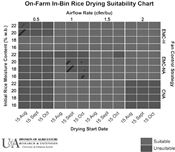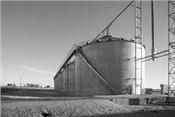Rice Processing Program Develops On-Farm Drying Guidelines To Maximize Quality, Reduce Energy
JOHN LOVETT
FAYETTEVILLE, ARKANSAS
The Arkansas Agricultural Experiment Station’s Rice Processing Program has released new recommendations to guide on-farm, in-bin rice drying in Arkansas to maximize quality and energy savings.
Griffiths Atungulu, interim director of the Rice Processing Program and associate professor of grain processing and post-harvest system engineering for the Experiment Station, the research arm of the University of Arkansas System Division of Agriculture, said the new guidelines are intended to balance rice quality, energy use and weather considerations.
“The real problem is that the weather may not allow complete drying of the rice, particularly the upper layers, in a timely manner,” said Atungulu. “When this happens, there is a great possibility for mold growth in the grain mass, with potential mycotoxin development and quality deterioration including staining, milling yield reduction, and sensory and functional problems.”
Using data compiled over nearly a decade, Atungulu’s team created an easy-to-read chart that offers guidelines for “suitable” and “unsuitable” drying operation ranges for Arkansas rice farmers during the harvesting months of August to October. Armed with this decision tool, producers will be in a better position to evaluate their rice drying needs, Atungulu said.
Rice growers commonly harvest rice once it reaches 20 percent moisture content. Rice producers store the rice in bins and begin the drying process to further reduce moisture content, Atungulu said. The optimum storage level of 12.5 percent moisture content wards off mold growth and helps maintain the rice’s structural quality for improved head yield.
Storing grain with too much moisture can lead to the formation of mycotoxins, especially aflatoxin. These are known carcinogens that pose a severe health hazard to humans and animals, Atungulu said.
Conversely, over-drying the grain can make it brittle and lead to decreased head yield from broken kernels.
Most on-farm systems in Arkansas use fans to blow either natural or slightly heated air to dry freshly harvested rice, Atungulu said.
However, weather conditions come into play when determining the duration required to achieve that 12.5 percent optimum moisture content.
Based on this research, Atungulu said a moisture content of 18-19 percent at harvest is now recommended for on-farm, in-bin drying systems. Harvesting at a lower moisture content can save energy to dry the grain to that optimum storage level.
Adopting technology
Arkansas rice farmers are steadily adopting moisture content monitoring technology, Atungulu said. The system is comprised of moisture content sensors buried vertically in the grain on cables, an on-site weather station and a controller that turns the drying fan on and off.
Algorithms based on the Equilibrium Moisture Content (EMC) principle, which determines the moisture content that a single grain will attain if exposed to air with a given relative humidity and temperature for a specific duration, determine if the external air is too humid to dry the rice, Atungulu said. Alternatively, if the system has a heater, it can control the humidity of the pushed air.
Atungulu said the cost to set up a new on-farm, in-bin drying system with moisture-sensing technology, a weather station, and a fan controller is about $14,000 for the first 48,000-bushel bin.
It becomes more cost-effective as more bins get linked to the system because only one weather station is needed. The cost reduces to about $10,000 for each subsequent bin. Atungulu said most Arkansas rice farmers do not opt for the air heaters, but they are not a significant expense to add to a system.
Since remote control of the drying operation is possible through the internet, some businesses have sprung up that provide remote moisture control of on-farm, in-bin systems, Atungulu said.
The Moisture Content Guideline chart
In 2013, the Rice Processing Program began working with manufacturing companies to collect data for properly calibrating rice-bin moisture control sensors. Atungulu said his team has been able to get the margin of error down to less than 1 percent for computer simulations using data collected in the field. Atungulu noted that the program cannot account for some variables like the amount of dust and chaff in the bin.
Atungulu used this data to develop a suitability chart, which addresses traditional systems that use continuous natural air without moisture monitors and the computer-assisted systems based on moisture content sensors.
The chart accounts for rice initial moisture content, typical airflow rates of 0.5, 1, 1.5 and 2 cubic feet of air per minute per bushel (cfm/bu), fan control strategy and drying start date. Fan control strategies include the traditional continuous natural air system (CNA) along with computer-assisted Equilibrium Moisture Content systems with both natural air (EMC-NA) and heated air (EMC-H).
The chart states that “suitability” does not factor in “quality” issues but rather focuses on “attaining safe storage,” which is 12.5 percent moisture content, drying duration of fewer than 30 days, maximum dry matter loss (DML) of less than 0.5 percent, and an over-drying rate of less than 10 percent.
The chart shows sensory technology systems with heated air capabilities offer the broadest range of optimum drying periods. A low- energy fan can also do the job when used with a heater. However, farmers do not like to introduce heat into the rough rice because the heat uses more energy and can compromise quality, Atungulu said.
Optimum drying periods can be achieved without heated air if a more robust fan is used.
Rice producers can use the chart by finding the intersection of their system’s airflow rate, fan control strategy, harvest date and initial moisture content. Suitable drying operation ranges in the chart are represented by boxes with diagonal lines in green and should provide enough time to safely reduce moisture content to 12.5 percent.
This University of Arkansas Rice Processing Program research expands the knowledge of a burgeoning practice of on-farm, in-bin rice drying for the nation’s No. 1 rice-producing state, Atungulu said.
Information gathered by the program with industry partners can lower energy usage in drying the rice by knowing when to shut fans down when the air is too humid and maintain the rough rice's structural integrity for maximum head yield after milling.
Support for this research was provided by rice check-off funding administered by the Arkansas Rice Research and Promotion Board and through contributions from the Rice Processing Program’s corporate sponsors. ∆
JOHN LOVETT: University of Arkansas

Suitability Chart was created by the Arkansas Agricultural Experiment Station's Rice Processing
Program using field data and computer modeling simulations for Arkansas rice growers.
UA System Division of Agriculture image

Arkansas rice farmers are adopting technologies that allow more efficient drying of rice on the farm.
UA System Division of Agriculture photo